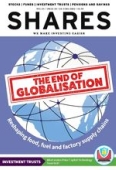Archived article
Please note that tax, investment, pension and ISA rules can change and the information and any views contained in this article may now be inaccurate.
The key things that could tell you if a US recession is coming

US Federal Reserve chair Jay Powell in his testimony to the US Senate Banking Committee in Washington declared a risk that America is heading into a recession. This represents refreshing honesty, especially for the head of an organisation with an unbroken record of failing to accurately predict any of the downturns seen since its foundation 109 years ago.
That shows just how difficult it is to spot a recession – America’s National Bureau of Economic Research was a year late in flagging the US downturn that started towards the end of 2007, a delay that rendered any such insight totally useless, especially from an investment point of view.
The question now is how can investors tell if Powell is right, especially as where America goes the world tends to follow?
LAGGING INDICATORS
In this respect GDP growth data is no use. It is published with a lag of a month or two and subsequently revised.
Unemployment data is similarly ineffective from an investment point of view, for the same reason.
Its only use may be as a contrarian indicator – once cyclical lows are hit then things can only get worse and vice-versa. US and UK unemployment rates currently stand at low levels. Job vacancy data may have more value.
Lagging indicators which carry more weight include retail sales and housing, as both tap into how 70% of the US economy is driven by consumption. This year’s weakness in retail sales and the way in which new home sales have fallen year-on-year 10 times in 11 months are potentially ominous.
CONCURRENT INDICATORS
Sentiment surveys may bring more insight. A good one to consider for the US is the NFIB smaller companies business survey. Just under 30 million US firms employ less than 500 people and they represent all bar a couple of percent of the total workforce. The NFIB has gone below 95 three times since 1985 and each time signalled a recession (the indicator got down to 96 in the 2001-02 downturn).
LEADING INDICATORS
Believers in financial markets may prefer to put their faith in forward-looking indicators and frankly there may be few better ones that financial assets. Investors have skin in the game and money is on the line. Economists do not.
Three useful benchmarks are small caps, transport stocks and copper.
Smaller companies tend to be much more sensitive to their local economy than mega-cap multi-nationals. The Russell 2000 index peaked before the 1991-92, 2001-02 and 2007-09 recessions.
‘Doctor Copper’ is a good guide to global economic health as the metal’s ductility and conductivity mean it is used in many industries across the globe. The current triple-top on the chart does look spookily like that of 2006-08.
Richard Russell’s Dow Theory states that industrials cannot do well if transport shares are doing badly, because weak transport stocks implies that goods are not being shipped because of an inventory pile-up, weak end-demand or both. By contrast, a surge in transport stocks suggests end-demand is good, because shelves and forecourts must be replenished, and the newly manufactured products must be moved around.
CONCLUSION
On the face of it, the outlook is difficult at best, grim at worst, although a downturn would take some of the heat out of inflation, if recent commodity price action is any guide. Investors must also bear in mind two other points.
First, the stock market is not the economy and vice-versa. If a downturn does hit, share prices will have gone down long before analysts begin cutting their forecasts and economists declare a recession. By the time the economists have woken up, there must be a chance that equities are already looking toward the next upturn.
Second, monetary stimulus from central banks and fiscal stimulus from governments could change sentiment. Most Western governments are potless but central banks can always turn to quantitative easing to help them and another firehose of cheap liquidity could galvanise risk assets.
If push comes to shove, central banks may be prepared to take their chances with inflation rather than recession, especially given the West’s indebted state.
As economist and shrewd stock market player J.M. Keynes wrote in 1923’s A Tract on Monetary Reform, ‘Inflation is unjust and deflation inexpedient. Of the two, perhaps deflation is worse; because it is worse in an impoverished world to provoke unemployment than to disappoint the rentier.’
Important information:
These articles are provided by Shares magazine which is published by AJ Bell Media, a part of AJ Bell. Shares is not written by AJ Bell.
Shares is provided for your general information and use and is not a personal recommendation to invest. It is not intended to be relied upon by you in making or not making any investment decisions. The investments referred to in these articles will not be suitable for all investors. If in doubt please seek appropriate independent financial advice.
Investors acting on the information in these articles do so at their own risk and AJ Bell Media and its staff do not accept liability for losses suffered by investors as a result of their investment decisions.
Issue contents
Feature
Great Ideas
Investment Trusts
News
- Apple aims to arrest sagging share price as new product launch rumours swirl
- Investment trusts prove to be key sources of dividends
- The earnings downgrade cycle has only just begun, suggesting more pain ahead
- Copper has entered a bear market and history tells us it’s not a good sign
- Why stock markets are taking Russia's debt default in their stride

 magazine
magazine












